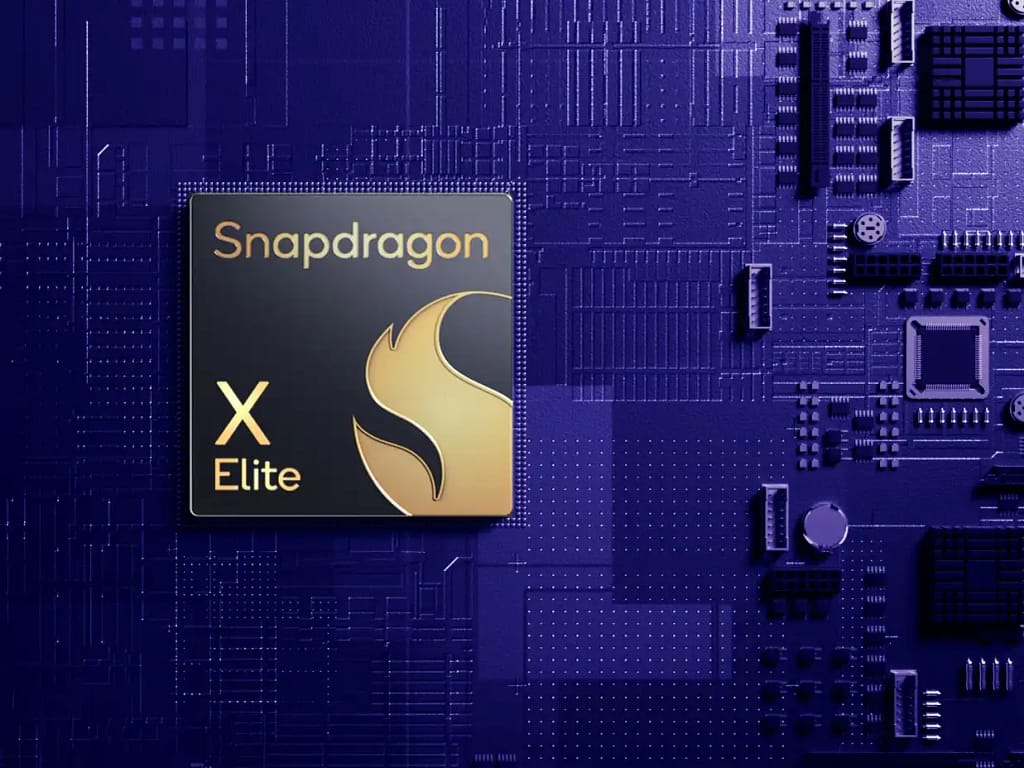Qualcomm, a prominent player in the semiconductor industry, has made some significant waves in the tech world with the recent unveiling of its Snapdragon X Elite processor. This processor, designed for laptops, aims to challenge Apple’s M2 chip and bring about a new era in laptop performance. The Snapdragon X Elite is no ordinary processor; it boasts 12 high-performance cores and is built on a 4-nanometer chip by TSMC. With a clock speed of 3.8 GHz and 12 cores, this chip represents a bold move by Qualcomm.
Unlike some other chip designs, the Snapdragon X Elite doesn’t include efficiency cores. In comparison, processors like the Apple M1 and M2 have both performance and efficiency cores to balance power consumption. This omission is intriguing, given that the Snapdragon X Elite was initially designed as a server chip before being repurposed for laptops.
Qualcomm claims that the Snapdragon X Elite can deliver twice the CPU performance of its competitors or match their peak performance while consuming only one-third of the power. These bold performance claims are undoubtedly impressive, but real-world testing will be necessary to validate them fully.
Snapdragon X Elite Features
The Snapdragon X Elite supports LPDDR5X RAM with a memory bandwidth of 136 Gbps and has 42 MB of total cache. This high-speed memory bandwidth and generous cache size should ensure that the 12 high-performance cores are well-fed with data, minimizing potential performance bottlenecks due to data access.
One notable feature of the Snapdragon X Elite is its clock speed flexibility. It operates at a base clock speed of 3.8 GHz, with two of its cores capable of boosting to 4.3 GHz when necessary. This flexibility should allow the processor to handle a wide range of tasks effectively, from demanding applications to power-efficient ones.
A significant point of interest in the tech world is whether the Snapdragon X Elite is based on ARMv8 or ARMv9 architecture. While Qualcomm’s Snapdragon mobile processors are based on ARMv9, the specific architecture of the Snapdragon X Elite remains undisclosed. It’s possible that the Snapdragon X Elite uses ARMv8, given its origin as a repurposed server chip, but this remains speculative.
The Snapdragon X Elite processor is set to power laptops starting in mid-2024, as per Qualcomm’s announcement. A diverse range of laptops is expected to adopt this chip, covering various thermal designs and performance characteristics, with active and passive cooling solutions.
Qualcomm’s performance claims extend to the GPU as well. The Snapdragon X Elite features an Adreno GPU that offers impressive capabilities, with support for up to 4.6 teraflops of performance and up to 4K resolution at 120 Hz on internal displays. It also allows for upgradable drivers, providing flexibility for future enhancements. However, Qualcomm’s recent practice of providing limited information about its GPUs, including core count and details, remains unchanged.
When it comes to GPU performance, Qualcomm claims that the Snapdragon X Elite provides twice the GPU performance of its competitors while consuming only one-fourth of the power. These performance figures are substantial, but the identity of the competing GPUs is left undisclosed. Knowing the specific GPUs being compared to the Snapdragon X Elite would provide a clearer perspective on its capabilities.
The Snapdragon X Elite is more than just a CPU and GPU; it also integrates a Hexagon NPU, forming the Qualcomm AI Engine. This AI engine can harness the power of the CPU, GPU, and NPU collectively, enabling enhanced AI and generative AI capabilities. Qualcomm touts the ability to run large language models with billions of parameters locally, ensuring privacy and reducing the reliance on cloud-based processing for tasks like language understanding and generation.
In terms of NPU performance, the Snapdragon X Elite achieves 45 TOPS (Trillion Operations Per Second) for the NPU alone. This level of NPU performance is substantial and offers significant potential for AI-driven applications on laptops. Additionally, the NPU can enable real-time background noise removal for better audio quality during video calls, a crucial feature in the current era of remote work and communication.
The Snapdragon X Elite provides robust support for SSDs with NVMe interfaces over PCIe 4.0, ensuring fast and efficient storage solutions. It also boasts support for the latest file system, UFS 4.0, enhancing data transfer speeds and file management.
Another standout feature is its video encoding and decoding capabilities, with support for 4K video at 60 frames per second, 10-bit color depth, and advanced codecs like H.264, H.265, and AV1. These capabilities make the Snapdragon X Elite an excellent choice for content creators and video enthusiasts.
In terms of connectivity and I/O, the Snapdragon X Elite features USB 4 support, which is essentially Thunderbolt integrated into the chip. This level of connectivity offers high-speed data transfer, daisy-chaining support, and compatibility with a wide range of peripherals. Additionally, it supports USB 3.2 Gen 2, further expanding its connectivity options.
Qualcomm’s Snapdragon X Elite represents a significant step in the evolution of laptop processors, promising superior CPU and GPU performance, exceptional AI capabilities, and an impressive array of features and connectivity options. With its expected launch in mid-2024, it will be fascinating to see how laptop manufacturers leverage this chip to create innovative and high-performance devices. Qualcomm’s bold claims will need to be validated through real-world testing, but the potential for a new era in laptop performance is undoubtedly exciting.
The Snapdragon X Elite has set a high bar, and it remains to be seen how it will perform in the competitive landscape of laptop processors. As we approach the release date, the tech world eagerly awaits benchmarking data and hands-on experiences with laptops powered by this cutting-edge chip.




